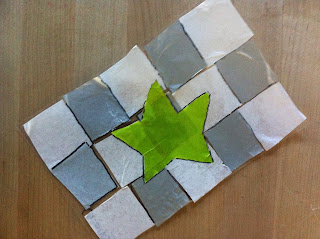(sorry, this is a picture of my dumb sample! I'll update it with kids' work as soon as I have pictures)
Another good December project. This is inspired by the stained glass that Matisse designed.
Materials: transparency paper (cut in half), tissue paper, elmer's glue (watered down by half), sponge brushes, scissors, and optional sharpies
Discussion: Using this slideshow, pass the first slide and focus on the second which is an image of a rose window designed by Matisse for a small chapel in NY (the other windows in the church are designed by Chagall - check it out! It's gorgeous). Use the VTS discussion questions to open your discussion: What do you see? What makes you say that? What more can you find? Depending on the kids ages, you could deepen the discussion by asking about: pattern and design - is there repetition? What does that contribute to the piece? Color - how does that affect the piece? Symbols - what do you think Matisse was trying to say? Materials - how does Matisse's use of glass affect the way this piece feels?
Activity: Have the kids think of a shape that has meaning to them - like a personal symbol - and have them cut it out using a piece of tissue paper. Set aside. Have the kids then cut smaller pieces for their backgrounds (if the kids are in the younger grades, I'd pre-cut these for sure). Cover the transparency with watered-down glue using the sponge brush and then have the kids go to town laying in their designs. If you have time for their pieces to dry you could have them trace over the edges with sharpie to simulate metal tracery like in the windows but that might be tricky, time-wise (I'll probably skip that when I do it).


















